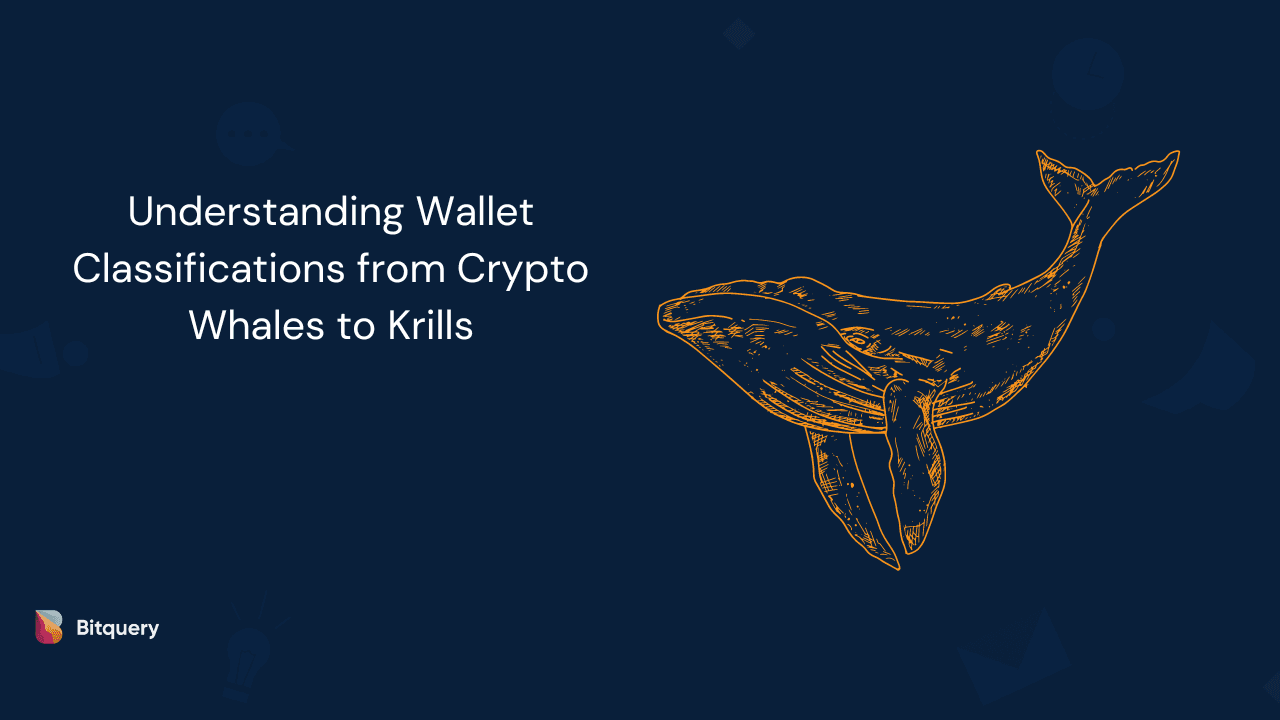
Understanding Wallet Classifications from Crypto Whales to Krills
Understanding Wallet Classifications: From Crypto Whales to Krills
Understanding how tokens are distributed among different wallet holders provides critical insights into the concentration of wealth and influence within any blockchain network. This comprehensive guide will teach you how to classify wallets, track whale activity, and analyze token distribution patterns using Bitquery's Token Holder APIs.
What We'll Discuss In This Blog
In this guide, you'll discover:
- Wallet Classification Systems: How to categorize holders from whales to krills
- Token Distribution Analysis: Why distribution matters for project health
- Whale Impact: How large holders influence markets
- Practical API Examples: Real queries to track holder metrics
- Distribution Statistics: Calculate Gini coefficient, Nakamoto coefficient, and more
Why Token Distribution Matters
Token distribution is a fundamental aspect of cryptocurrency ecosystems that directly impacts stability, decentralization, and overall network health. Understanding who holds tokens and in what quantities is often more important than simply knowing the total number of holders.
Key Benefits of Proper Token Distribution
Decentralization & Security
- Prevents concentration of power in few addresses
- Enhances network resilience against attacks
- Reduces single-point-of-failure risks
Market Health
- Promotes liquidity and price stability
- Reduces manipulation risks
- Enables sustainable growth patterns
Community & Trust
- Ensures equitable participation opportunities
- Builds stakeholder confidence
- Encourages active community engagement
Project Sustainability
- Attracts diverse global participation
- Provides transparent allocation visibility
- Creates long-term holder alignment
Wallet Classification System
Cryptocurrency wallets are commonly categorized based on token holdings, creating a hierarchical classification system. These thresholds vary depending on the token's value against fiat currencies, but the general framework remains consistent across the industry.
Classification Tiers
| Category | Token Holdings | Market Influence | Typical Role |
|---|---|---|---|
| Whales | > 1,000,000 tokens | Very High | Major investors, early adopters, institutions |
| Sharks | 100,000 - 1,000,000 | High | Significant traders, large investors |
| Dolphins | 10,000 - 100,000 | Moderate | Active traders, medium investors |
| Seals | 1,000 - 10,000 | Low-Moderate | Regular investors, early enthusiasts |
| Fish | 100 - 1,000 | Low | Small investors, retail traders |
| Krill | 0 - 100 | Minimal | Micro investors, new users |
Token Value Matters
These thresholds are guidelines and should be adjusted based on token economics. A whale holding 1M tokens worth $0.01 each differs significantly from one holding 1M tokens worth $100 each.
The Significance of Whales
Crypto whales—holders with 100,000+ tokens—exert disproportionate influence on market dynamics, price movements, and overall ecosystem health. Understanding whale behavior is essential for any serious market participant.
How Whales Impact Markets
1. Price Volatility
Whales can trigger significant price movements through large transactions:
- Selling Pressure: Large sell orders create sharp downward pressure, potentially triggering panic selling
- Buy Walls: Substantial purchases can rapidly increase prices and spark buying frenzies
- Psychological Impact: Whale movements often influence retail trader behavior
2. Market Liquidity
Whales play a dual role in market liquidity:
- Positive: Provide depth to order books, enabling smoother trading
- Market Making: Large orders allow others to trade without excessive slippage
- Negative: Sudden liquidity withdrawal increases volatility and spreads
- Concentration Risk: Over-reliance on few holders creates instability
3. Market Manipulation Risks
Large holders possess tools for market manipulation:
- Wash Trading: Creating artificial volume through self-trading
- Spoofing: Placing large orders to manipulate price, then canceling them
- Pump & Dump: Coordinated buying followed by mass selling
- Accumulation Games: Suppressing prices to accumulate before major moves
4. Investor Sentiment
Whale activity serves as a market signal:
- Accumulation Phases: Large buys often indicate confidence in future price appreciation
- Distribution Phases: Consistent selling may signal upcoming bearish trends
- Smart Money Indicators: Experienced traders monitor whale wallets for strategic insights
- Confidence Metrics: Whale holding patterns influence overall market sentiment
⚠️ Monitor Whale Activity
Tracking whale movements provides early warning signals for potential market shifts. Use Bitquery's Token Holder APIs to identify and monitor large holders in real-time.
Analyzing Token Distribution with Bitquery APIs
Now let's explore practical examples using Bitquery's Token Holder APIs to analyze wallet classifications, track distribution patterns, and monitor whale activity across popular tokens.
Example 1: Categorized Count of USDT Token Holders
This query retrieves USDT holder counts across different wallet classifications—whales, sharks, and dolphins—providing insights into token concentration.
Run in IDE: USDT holder distribution by tier
{
EVM(dataset: archive, network: eth) {
TokenHolders(
date: "2024-02-01"
tokenSmartContract: "0xdAC17F958D2ee523a2206206994597C13D831ec7"
where: { Balance: { Amount: { ge: "0" } } }
) {
whales: count(
distinct: Holder_Address
if: { Balance: { Amount: { gt: "1000000" } } }
)
sharks: count(
distinct: Holder_Address
if: { Balance: { Amount: { gt: "100000", le: "1000000" } } }
)
dolphins: count(
distinct: Holder_Address
if: { Balance: { Amount: { gt: "1000", le: "100000" } } }
)
}
}
}
Key Insights:
- Dolphins (1K-100K tokens): Represent the majority with 223,459 holders, indicating healthy retail participation
- Sharks (100K-1M tokens): 20,288 holders form the active trading tier
- Whales (>1M tokens): Only 3,753 holders, but they control significant supply
This distribution pattern suggests relatively healthy decentralization, though whales still maintain considerable influence.
Example 2: Top Token Holders for MAYC NFT Collection
Identify the largest holders of the Mutant Ape Yacht Club (MAYC) NFT collection to understand ownership concentration patterns.
Run in IDE: Top MAYC holders
{
EVM(dataset: archive, network: eth) {
TokenHolders(
date: "2024-02-01"
tokenSmartContract: "0x60E4d786628Fea6478F785A6d7e704777c86a7c6"
limit: { count: 10 }
orderBy: { descending: Balance_Amount }
) {
Holder {
Address
}
Balance {
Amount
}
BalanceUpdate {
FirstDate
LastDate
}
}
}
}
Analysis:
- Concentration Gradient: Top holder owns 785 tokens while 10th holder owns 55 tokens, showing a natural concentration curve
- Whale Dominance: Top 10 holders control a significant portion but not overwhelming majority
- Positive Distribution: Multiple diverse holders indicate healthy decentralization rather than extreme concentration
- Monitoring Opportunity: Track these addresses over time to identify accumulation or distribution trends
Example 3: Trending Tokens by Holder Growth
Discover which tokens are gaining the most holders, indicating growing community adoption and interest.
Run in IDE: Trending tokens by holder count
{
EVM(network: eth, dataset: combined) {
BalanceUpdates(
where: {
Block: { Date: { since: "2024-02-01" } }
BalanceUpdate: { Amount: { gt: "0" } }
}
orderBy: { descendingByField: "No_Holders" }
limit: { count: 10 }
) {
No_Holders: count(distinct: BalanceUpdate_Address)
Currency {
Name
Symbol
SmartContract
}
}
}
}
Insights:
- Native ETH Dominance: Highest holder count reflects fundamental network adoption
- Stablecoin Utility: USDT and USDC rank high, demonstrating their role as trading pairs and value stores
- DeFi Tokens: Staking tokens (e.g., stETH) show growing DeFi participation
- Ecosystem Projects: Application-specific tokens indicate active community engagement
- Adoption Metric: Increasing holder count often precedes price appreciation
💡 Related Documentation
For more token holder query examples, visit our Token Holder API Guide
Advanced Token Holder Analysis
The Token Holders API provides comprehensive capabilities for analyzing wallet classifications and distribution patterns. Here's how to leverage these powerful features:
Core Capabilities
1. Holder Counting & Classification
- Total Holder Count: Track overall token adoption and network growth
- Categorized Counts: Segment holders into whales, sharks, dolphins, etc.
- Time-Series Analysis: Monitor holder growth patterns over time
- New vs. Existing: Identify fresh entrants versus long-term holders
2. Balance Tracking & Monitoring
- Historical Balances: Query any address's token balance at specific dates
- Balance Changes: Track accumulation or distribution patterns
- Portfolio Analysis: Monitor multiple tokens across addresses
- Threshold Alerts: Identify when addresses cross classification boundaries
3. Statistical Measures
The API provides advanced metrics for decentralization analysis:
| Metric | Purpose | Use Case |
|---|---|---|
| Gini Coefficient | Wealth inequality (0-1 scale) | Assess distribution fairness |
| Nakamoto Coefficient | Decentralization threshold | Identify minimum colluding actors needed |
| Theil Index | Entropy-based inequality | Advanced distribution analysis |
| Average Balance | Mean holder position | Understand typical holder size |
| Median Balance | Central tendency | True "middle" holder position |
4. Activity Analysis
- Transaction Counts: Track holder trading frequency
- First/Last Activity: Identify dormant vs. active wallets
- Inflow/Outflow: Monitor buying and selling patterns
- Liquidation Events: Detect complete position exits
5. Top Holder Identification
- Whale Addresses: Find largest holders by balance
- Influential Stakeholders: Identify major investors and institutions
- Risk Assessment: Evaluate concentration risks
- Smart Money Tracking: Monitor experienced trader movements
6. Advanced Filtering
- Balance Ranges: Filter holders within specific token amounts
- Date Ranges: Analyze holder behavior across time periods
- Multiple Criteria: Combine filters for sophisticated analysis
- Common Holders: Find addresses holding multiple specific tokens
Practical Use Cases
Understanding wallet classifications enables powerful applications across the crypto ecosystem:
For Traders & Investors
- Whale Watching: Monitor large holder movements for early market signals
- Smart Money Tracking: Follow successful traders and their strategies
- Risk Assessment: Evaluate token concentration before investing
- Entry/Exit Timing: Use distribution changes to optimize trade timing
For Project Teams
- Community Health: Monitor holder diversity and growth
- Token Economics: Validate distribution aligns with tokenomics design
- Vesting Tracking: Monitor team and investor unlock schedules
- Marketing Insights: Identify successful holder acquisition strategies
For Researchers & Analysts
- Decentralization Metrics: Calculate Gini, Nakamoto, and Theil coefficients
- Market Research: Compare distribution patterns across projects
- Trend Analysis: Identify correlation between distribution and price
- Due Diligence: Assess project legitimacy through holder patterns
For DeFi Protocols
- Governance Analysis: Understand voting power distribution
- Risk Management: Monitor concentration risks in liquidity pools
- Airdrop Planning: Design fair distribution based on holder tiers
- Incentive Design: Target specific holder categories with rewards
Key Takeaways
Token distribution is more important than total holder count - Understanding who holds tokens and how much reveals true project health
Whales significantly impact markets - Large holders influence price volatility, liquidity, and sentiment through their trading activity
Classification enables better analysis - Segmenting holders into tiers (whales, sharks, dolphins, etc.) provides actionable insights
Monitor distribution changes over time - Tracking holder patterns reveals accumulation, distribution, and trend signals
Bitquery APIs make analysis accessible - Comprehensive token holder data available through simple GraphQL queries
Next Steps
Ready to start analyzing token distributions? Here's what to do next:
- Try the Token Holder API - Explore comprehensive examples and queries
- Get Your API Key - Start with free tier access
- Join Our Community - Connect with other developers and analysts
- Explore More Examples - Advanced use cases and patterns
Related Resources
Expand your knowledge with these related guides:
Token Holder Analytics
- Token Holder API Guide - Complete API reference and examples
- Balance Updates Cube - Track balance changes over time
- Token Holders Over Time - Historical analysis patterns
Distribution Metrics
- Statistics & Metrics - Gini, Nakamoto, and Theil calculations
- Calculations - Custom metric computations
- Filtering Techniques - Advanced query filtering
Market Analysis
- DEX Trades API - Analyze trading activity
- Token Trades APIs - Track buy/sell patterns
- Transfers API - Monitor token movements
Getting Started
- First Query Guide - Learn GraphQL basics
- API Authentication - Get your API key
- IDE Features - Master the query interface
Support & Community
Need help or have questions?
- Telegram Community - Get support from our team and community
- Documentation - Comprehensive guides and references
- GitHub Examples - Code samples and integrations
- Email Support: support@bitquery.io
Subscribe to our newsletter
Subscribe and never miss any updates related to our APIs, new developments & latest news etc. Our newsletter is sent once a week on Monday.


